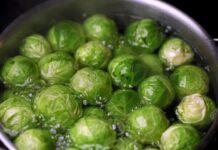Turnips are a nutritious and versatile root vegetable, perfect for adding texture and flavor to soups, stews, and casseroles. If you’ve got a surplus of turnips or want to preserve them for later use, freezing is a great option. Freezing turnips properly ensures that they maintain their flavor, texture, and nutritional value, making them a convenient ingredient to have on hand for your favorite comfort foods. Here’s a step-by-step guide to freezing turnips, with a focus on using them in soups and stews.
Why Freeze Turnips?
- Long-Term Storage: Freezing preserves turnips for several months, allowing you to enjoy them long after their harvest season.
- Easy Meal Prep: Having frozen turnips on hand means you can quickly add them to soups, stews, and other dishes without needing to peel and chop fresh vegetables.
- Nutrient Retention: Proper freezing ensures that turnips retain most of their vitamins and minerals, so you can enjoy their health benefits year-round.
What You’ll Need
- Fresh turnips
- Knife and cutting board
- Peeler (optional)
- Large pot for blanching
- Bowl of ice water
- Colander or strainer
- Baking sheet
- Parchment paper (optional)
- Freezer-safe bags or airtight containers
- Marker for labeling
Step-by-Step Guide to Freezing Turnips for Soups and Stews
1. Choose Fresh, Firm Turnips
Pick turnips that are firm, with smooth, unblemished skins and no soft spots. Avoid turnips that are overripe, as their texture can become woody and undesirable when frozen. Smaller turnips are often more tender and freeze better than larger ones.
2. Clean and Peel the Turnips
- Wash the turnips thoroughly under cold running water to remove any dirt.
- Peel the skins using a vegetable peeler. Although you can leave the skins on if you prefer, peeling turnips before freezing will give you a smoother texture when you cook them later.
- Cut the turnips into uniform pieces (such as cubes or slices) to ensure even cooking when you use them later. You can also leave them whole if preferred, but chopped pieces tend to freeze better and cook faster.
3. Blanch the Turnips
Blanching helps preserve the color, flavor, and texture of turnips while they freeze. It also helps stop the enzymes in the vegetable from breaking down, which could cause them to lose flavor.
- Bring a large pot of water to a boil.
- Add the prepared turnip pieces to the boiling water and blanch for 2-3 minutes (whole turnips may need 5-6 minutes).
- Immediately transfer the blanched turnips to a bowl of ice water to halt the cooking process. Leave them in the ice water for about 3-5 minutes.
- Drain the turnips thoroughly in a colander.
4. Dry the Turnips
Before freezing, make sure the turnips are as dry as possible to prevent ice crystals and freezer burn. Use a clean towel or paper towels to pat them dry.
5. Pre-Freeze the Turnips
- Line a baking sheet with parchment paper.
- Spread the blanched turnips in a single layer on the baking sheet, ensuring the pieces aren’t touching.
- Place the baking sheet in the freezer for 1-2 hours or until the turnips are frozen solid. Pre-freezing helps the turnips freeze individually, so they won’t clump together in storage.
6. Transfer to Freezer Bags or Containers
- Once the turnips are fully frozen, transfer them to freezer-safe bags or airtight containers.
- Remove as much air as possible from the bags to avoid freezer burn.
- Label the bags or containers with the date and contents (e.g., “Blanched Turnips – Jan 2025”).
7. Store in the Freezer
Store the turnips in the freezer at 0°F (-18°C) or lower. They will last for up to 12 months, but for the best quality, try to use them within 6-8 months.
Tips for Using Frozen Turnips in Soups and Stews
- Add Directly to Hot Dishes: Frozen turnips can be added directly to soups and stews without thawing. They will soften as they cook and take on the flavors of the dish.
- Use in Mashed Dishes: Frozen turnips can be mashed after cooking, giving a creamy texture similar to mashed potatoes.
- Flavor Pairing: Turnips work well with a variety of herbs and spices, including thyme, rosemary, garlic, and black pepper. Consider seasoning them during cooking for the best results.
- Cook in Broth: To enhance the flavor of frozen turnips, cook them in broth (vegetable, chicken, or beef) instead of water. This will infuse them with extra taste as they thaw and cook in your soups and stews.
Common Mistakes to Avoid
- Skipping the Blanching Process: Blanching is crucial to preserving the flavor and texture of the turnips. Without it, the turnips may become mushy and lose their taste when frozen.
- Not Drying the Turnips Enough: If turnips aren’t dried properly before freezing, they can develop freezer burn or form ice crystals, which will affect their texture when cooked.
- Overcrowding the Freezer Bags: If you pack the turnips into the bags too tightly, they may freeze together in clumps. Make sure they are spread evenly in the bags for easy portioning.
Advantages of Freezing Turnips
- Convenience: Having frozen turnips means you can easily add them to soups and stews without needing to peel and chop fresh vegetables each time.
- Preserves Nutrients: Freezing helps retain the vitamins and minerals in turnips, so you can enjoy their health benefits all year round.
- Space-Saving: Freezing turnips is a great way to store them when you have an excess from the garden or farmer’s market, reducing food waste and saving space in your refrigerator.










